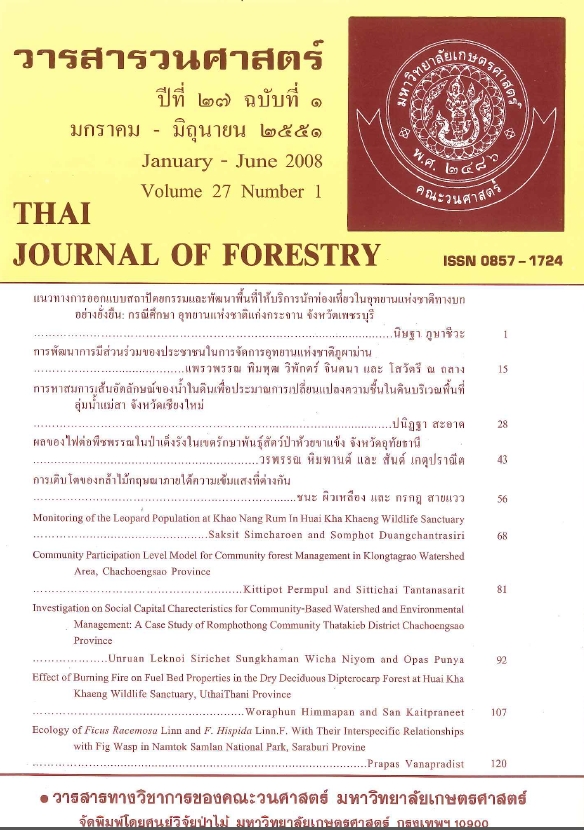การพัฒนาการมีส่วนร่วมของประชาชนในการจัดการอุทยานแห่งชาติภูผาม่าน
Main Article Content
บทคัดย่อ
การวิจัยนี้มีเป้าหมายเพื่อศึกษารูปแบบการมีส่วนร่วมและประเมินประสิทธิผล จากการคำเนิน โกร งการนำร่องการ พัฒนาการมีส่วนร่วมเพื่อการ จัดการอุทยานแห่งชาติอย่างยั่งยืนของอุทยานแห่งชาติภูผาม่าน โดยใช้วิธีตรวจเอกสาร และสัมภาษณ์กลุ่มตัวอย่างซึ่งเป็นตัวแทนครัวเรือนในพื้นที่ ตรงการฯ จำนวน 261 ราย วิเคราะห์ทางสถิติโดยใช้ค่าร้อยละโกรงการนี้เป็น โกรงการที่ภาครั ฐริเริ่มขึ้นเพื่อแก้ไขปัญหาความขัดแย้งในการจัดการอุทยานแห่งชาติโดยประชาชนมีส่วนร่วม วิธีการมีส่วนร่วมลักษณะนี้เป็นการมีส่วนร่วมแบบถูกชักนำ ซึ่งประกอบด้วย 19 กิจกรรมส่วนใหญ่ (ร้อยละ 74) เป็นรูปแบบการมีส่วนร่วมที่ให้ประชาชนเข้าร่วมโดยตร ง ที่เหลือมีรูปแบบการมีส่วนร่วมโดยผ่านกลุ่มและโดยผ่านตัวแทนตามลำดับ สำหรับกระบวนการมีส่วนร่วม พบว่า มีเพียงหนึ่งในสี่ของกิจกรรมทั้งหมดที่มีการดำเนินงานตามกระบวนการมีส่วนร่วมครบทั้ง 4 ขั้นตอน ตั้งแต่ การรับรู้ข้อมูลข่าวสาร การคิดวิเคราะห์ปัญหาและวางแผน การคำเนินงานและรับประ โยชน์ และการติดตามประเมินผล จากการศึกษา พบว่ากลุ่มตัวอย่างร้อยละ 63 มีส่วนร่วมในขั้นตอนแรก ร้อยละ 53. 39 และร้อยละ 23 มีส่วนร่วมในขั้นตอนที่สอง ขั้นตอนที่สามและขั้นตอนที่สี่ ตามลำดับ จากการประเมินประสิทธิผลการดำเนิน โครงการฯ พบว่า ด้านสังคมและความมั่นคง ชุมชนได้จัดตั้งองค์กรชุมชนและกำหนดกดิกาในการใช้ประ โยชน์ทรัพยากรของชุมชน ซึ่งร้อยละ 80 มีการยอมรับ ในการบริหารองค์กรชุมชน ร้อยละ 85 เห็นว่าคณะกรรมการ โครงการฯ มีความสามารถ ร้อยละ 14 เห็นว่ามึงบประมาณและวัสดุอุปกรณ์เพียงพอ ค้านการพัฒนาเศรษฐกิจและคุณภาพชีวิต กลุ่มตัวอย่างร้อยละ 56 มีคุณภาพชีวิตดีขึ้น ร้อยละ 6 มีโอกาสประกอบอาชีพมากขึ้น ร้อยละ 72 มีความมั่นกงเรื่องที่อยู่อาศัยและที่ทำกิน ขณะที่ร้อยละ 3 มีรายได้เสริม ด้านความยั่งยืนของทรัพยากรธร รมชาติและสิ่งแวคล้อม กลุ่มตัวอย่างร้อยละ 33 ทำเกษตรอินทรีย์ เพื่อช่วยอนุรักษ์สิ่งแวดล้อม ร้อยละ 78 เห็นความสำคัญในการป้องกันทรัพยากร ธรรมชาติ โดยร้อยละ 56 เข้าร่วมทำฝ่ายอนุรักษ์ดินและน้ำ ร้อยละ 90 ไม่ขยายที่ดินในเขตอุทยานฯ ร้อยละ 89 ร่วมฟืนฟูป่าไม้
คำสำคัญ: การพัฒนา การมีส่วนร่วม การ จัดการ อุทยานแห่งชาติภูผาม่าน
Downloads
Article Details

อนุญาตภายใต้เงื่อนไข Creative Commons Attribution-NonCommercial-NoDerivatives 4.0 International License.
ข้าพเจ้าและผู้เขียนร่วม (ถ้ามี) ขอรับรองว่า ต้นฉบับที่เสนอมานี้ยังไม่เคยได้รับการตีพิมพ์และไม่ได้อยู่ในระหว่างกระบวนการพิจารณาตีพิมพ์ลงในวารสารหรือสิ่งตีพิมพ์อื่นใด ข้าพเจ้าและผู้เขียนร่วม (ถ้ามี) ยอมรับหลักเกณฑ์และเงื่อนไขการพิจารณาต้นฉบับ ทั้งยินยอมให้กองบรรณาธิการมีสิทธิ์พิจารณาและตรวจแก้ต้นฉบับได้ตามที่เห็นสมควร พร้อมนี้ขอมอบลิขสิทธิ์ผลงานที่ได้รับการตีพิมพ์ให้แก่วารสารวนศาสตร์ คณะวนศาสตร์ มหาวิทยาลัยเกษตรศาสตร์ กรณีมีการฟ้องร้องเรื่องการละเมิดลิขสิทธิ์เกี่ยวกับภาพ กราฟ ข้อความส่วนใดส่วนหนึ่ง หรือ ข้อคิดเห็นที่ปรากฏในผลงาน ให้เป็นความรับผิดชอบของข้าพเจ้าและผู้เขียนร่วม (ถ้ามี) แต่เพียงฝ่ายเดียว และหากข้าพเจ้าและผู้เขียนร่วม (ถ้ามี) ประสงค์ถอนบทความในระหว่างกระบวนการพิจารณาของทางวารสาร ข้าพเจ้าและผู้เขียนร่วม (ถ้ามี) ยินดีรับผิดชอบค่าใช้จ่ายทั้งหมดที่เกิดขึ้นในกระบวนการพิจารณาบทความนั้น”


